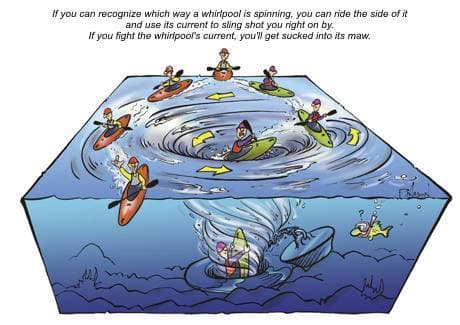Managing Whirlpools
The following is a modified excerpt from Ken Whiting's book, 'The Ultimate Guide to Whitewater Kayaking'
The term whirlpool describes the action of water flowing in a downward spiral. It is caused by the collision of opposing flows, as with an eddy line. While small, the whirlpool is at most an unstable place for a paddler, but when the currents involved are powerful enough, the whirlpool can become a very entertaining or intimidating phenomenon. Big whirlpools can suck a person and even a kayak under water, which can be fun if done intentionally, but not so fun if it is a surprise.
When running a high-volume river, you'll probably spend a lot more of your time avoiding whirlpools than playing in them, and this isn't always easy to do. In many cases, whirlpools (like boils) can be totally unpredictable and pop up in front of you unexpectedly. Fortunately there is a way to deal with them if you can't miss them. You can actually enter the whirlpool and use its energy to your advantage to get through it. The helical flow of a whirlpool offers you a free ride if you make your way into the right part of the swirling water. If you successfully paddle into the part of a whirlpool's swirling current that is moving downstream, then you can slingshot yourself around and out the other side using this current for a nice boost. This slingshot technique uses a similar concept to that which allows satellites to resist the gravitational pull of the earth and maintain orbit. Of course, this means paddling into a side of the whirlpool and not into its centre.
50 years of lightweight, maneuverable, high-performing kayaks.
Check out this interview with Tom Keane, Eddyline Kayaks Co-Owner, on their journey!
If for some reason you find yourself in the eye of the whirlpool, your momentum will be lost and there's not much you can do but hold on and wait for the opportunity to escape. If the whirlpool is big enough, your boat will sometimes be pulled completely underwater. This can be nerve-racking (or exhilarating), but you can take comfort in the fact that the whirlpool will eventually die out. Sometimes it will take only seconds for a whirlpool to grow and then disappear, while others can last ten seconds or longer. Invariably, though, the whirlpool will settle out as it moves downstream. This is nice to know when you find yourself upside down in a whirlpool, because it can sometimes be very difficult to roll. If you're having trouble rolling, or even moving your paddle into a set up position, try to relax and wait for the whirlpool to dissipate. Unfortunately, the only way to really develop your comfort level with whirlpools is to play around in them. So next time you get to that squirrelly spot on your local river, throw on your nose plugs and start messing around.

Illustration by Paul Mason
Ken is a World Champion Kayaker and the author and producer of an award winning series of instructional kayaking books and videos. He was recognized by "Paddler Magazine" as one of their 'Paddlers of the Century'. For more information, visit www.helipress.com.
Related Articles
How many of you have ever heard that paddle craft (vessels under oars according to the Navigation Rules)…
Even though they are flipping over, missing their gates and failing their maneuvers, they still look…
The following is a modified excerpt from Ken Whiting's book, 'The Ultimate Guide to Whitewater…
One of the biggest reasons stand up paddling has exploded in popularity is because it offers something…




